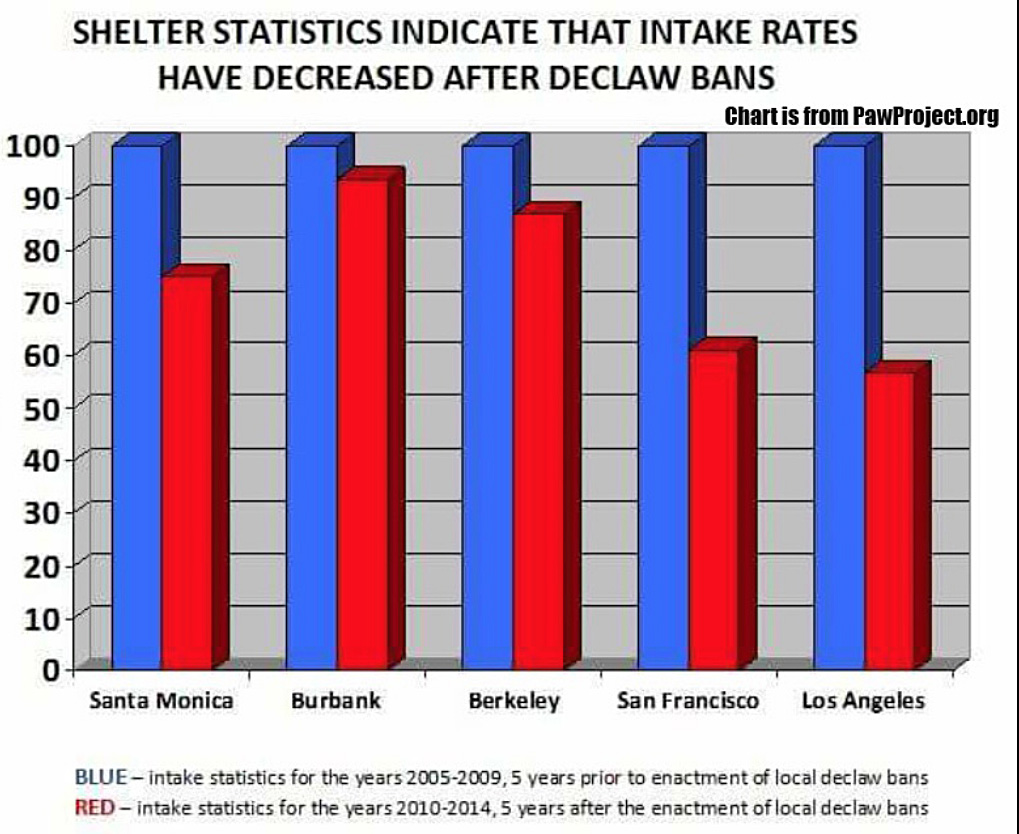This story was published in March 2016 and updated in 2025.
This was the ASPCA’s official 2015 declawing position-
“The ASPCA is strongly opposed to declawing cats for the convenience of their guardians. The only circumstance in which the procedure could be condoned would be if the health and safety of the guardian would be put at risk, as in the case of individuals with compromised immune systems or illnesses that cause them to be unusually susceptible to serious infections.” Link to this 2015 Position- ASPCA’s 2015 Declawing Position
The ASPCA updated their declawing position in 2016 to this. Here it is ASPCA’s declawing position statement
Then the ASPCA came up with a new excuse for not supporting banning declawing and here it is, “Legislation to make declawing illegal, while well-intentioned, can be problematic, because, in rare cases, the procedure may be justifiable as a last resort to prevent euthanasia. There is also no meaningful way to enforce a law that includes this exception.”
The ASPCA also uses the death or declaw excuse in their destructive scratching section. ASPCA Destructive Scratching
The ASPCA says do not declaw cats in their Cat Grooming Tips section. ASPCA Do Not Declaw
This is the last we heard from the ASPCA about this issue when they sent this note to many of City the Kitty’s supporters in 2017 and the note to City the Kitty’s exec. director. There are lies in their note. Laser declawing is not better than the other methods and it’s just as mutilating. There are many studies that prove that declawing causes behavioral issues.
“Dear Friends of Animals,
Here’s the note to City the Kitty’s Exec. Director on March 15, 2017.
“It looks like you’ve already viewed our updated position on cat declawing: http://www.aspca.org/about-us/aspca-policy-and-position-statements/position-statement-declawing-cats. We continue to strongly oppose the procedure. As noted in the statement, our experts believe that legislation to make declawing illegal, while well-intentioned, can be problematic, because, in rare cases, the procedure may be justifiable as a last resort to prevent euthanasia.
All the best,
Olivia
Olivia Melikhov
Senior Manager, Social Media
Media and Communications
ASPCA®”
Here is a note they sent to us in 2015.
” I had to consult with a few departments and experts internally here. Our organization is opposed to the inhumane practice of cat declawing and we think it’s really admirable that you and City the Kitty are working to raise awareness about this important issue. We are actually in the process of working with our experts to revise and update our position on declawing. In the meantime, we are refraining from participating in proactive advocacy on the issue.
All the best,
Olivia
Olivia Melikhov
Senior Manager, Social Media
ASPCA®
520 Eighth Avenue, 7th floor
New York, NY 10018″
—————————————-
Facts- There are thousands of declawed cats that are in shelters/rescues after they were thrown away because of the behavioral issues they have from their declaw procedure. Many are being euthanized. There are many declawed cats who are dying on the operating (torture) table while they are being declawed. ALL declawed cats have to walk for the rest of their lives with some sort of pain and discomfort from being declawed.
A new peer reviewed study came out in Sept. 2021 that showed that banning declawing doesn’t result in an increase in cat relinquishment or euthanasia. Here’s the study. Declaw ban
Here’s a quote from Brenda Barnette, General Manager of Los Angeles Animal Services Dept., “I am the General Manager of Los Angeles Animal Services Department (LAAS), which operates the public animal shelters in Los Angeles, a city of over 4 million. Los Angeles, where declawing has not been permitted since 2009, has a proud tradition of being on the forefront in the humane treatment of animals.
Since the declaw ban, the number of cats entering our shelters dropped 43.3%. I attribute the decrease in relinquishment of cats to a decrease in behavioral problems, particularly biting and litter box avoidance, which are widely recognized to be the result of declawing and that are reasons for cats to be surrendered to shelters. Furthermore, our adoption rate for cats has actually increased. We at LAAS strongly believe that a no-declawing policy saves the lives of cats.”
It is a common misconception among veterinary professionals that scratching behavior is one of the most common reasons for relinquishment of cats to shelters. Our experience and that of shelter operators has taught us differently. Other problems, house soiling and aggression, are listed as the top two behavioral reasons cats lose their homes. Scratching behavior is far down the list, right next to reasons like the cat requires too much attention, and scratching is rarely a reason given for relinquishment.”
AAFP banned declawing in all their Cat Friendly Practices in July 2021.
Fear Free Pets announced they will ban declawing in all their practices on Dec. 31, 2021.
Declawing was banned in New York State in July 2019 and there hasn’t been an increase of cats in shelters or cats being euthanized in that state. Here is a June 26, 2020 statement from the biggest animal shelter in the world that is based in New York. North Shore Animal League America.
“We are approaching the one year mark since the ban went into effect on July 22nd, 2019. We have not seen an increase in owner surrendered cats as a result of the ban. NSALA supported the ban and did not provide declawing services in our Pet Health Centers even before the ban went into effect. There are many other humane options to address the cat’s innate need to scratch. We have seen firsthand the damage caused by declawing both physically and behaviorally when owners want to surrender their declawed cats. We are happy to know that this practice has stopped in New York.
Joanne Yohannan, Senior Vice President of Operations, North Shore Animal League America”
Here’s another statement from Animal Care Centers of NYC .
“June 26, 2020
Anyone thinking that the declawing ban would lead to an increase in cat surrenders in New York City might be surprised to learn that ACC, the only open-admission shelter in NYC, has actually seen a decline in cat intake. At the same time we have seen a 25% increase in the amount of direct adoptions our organization has processed over the past year. The ban does not seem to have affected people’s desire to adopt cats in their natural state.
Katy Hansen
Director of Marketing and Communications
Animal Care Centers of NYC”
These cats were all declawed and thrown away by their owners.
Also, here are facts! In the cities where declawing was banned in California AND in Denver, data from the shelters shows that that number of cats in shelters DECREASED after the declawing bans.
![]()
Here’s one of the many examples that shows declawing doesn’t guarantee a cat will stay in a home and often the opposite happens. Humane Society of Midland County Story
https://citythekitty.org/declawing-does-not-keep-a-cat-a-home/


